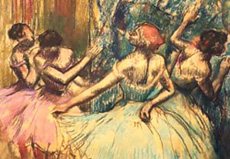Kasama Nichido Museum of Art:English
Collection
 |
"Dancers in the Wings" (c.1897-1901)
Edgar DEGAS (1834-1917)
Date ca. 1897-901
Materials/ Techniques charcoal, pastel drawing, paper
Size 80 x 105 cm
|
Degas is widely known as a painter favored in the scenes of ballet dancers. It was when he was 40 years old, he thoroughly set about the subject. He had solidified his position as a great painter though frequently visiting the ballet stages, and grasped and drew the lively visions of ballerinas on stages, in the wings and at their back stages.
Degas created his paintings indoors, after many careful sketches. The realistic depictions and the distinctive compositions of Degas are taken as the influences of novel designs of photographs and ukiyo-e (Japanese prints). He had a collection of more than 100 ukiyo-e, and it is said he displayed some ukiyo-e in his bed room.
Degas was born in a wealthy family, but he was burdened with a large debt after his father engaged in banking passed away in 1874 when he was 40 years old. It was the year when he sent his paintings to the first Impressionists Exhibition. While Degas was a good-looking man and Parisiennes passing by turned to look at him, he did not get married, and kept on carrying his sketch book every day, and sketched around various people of every social class in Paris. When he was around 50 years old, however, he began to lose his eyesight.
"Dancers in the Wings" is a pastel painting which was drawn just before Degas gave up his paintings. He was completely about to lose his sight at the time he worked on this painting. Degas said as follows: While it is fine to sketch visible things, it is better to draw what is still seen in memories. Then imagination and memories work together, and we can depict something that gave us deep impressions, in other words, the essence of subjects.
Once Degas drew fine pieces as "la classe de danse (Dance Class)" and "l'etoile (The Star Dancer on Stage)" of the Musse d'Orsay, facing with the ballet dancers, and drew careful sketches. The "Dancers in the Wings" of his later years can be described as the piece that "depicts the essence of the subjects."
|

